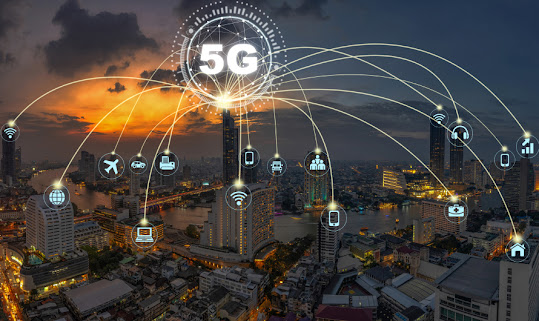5G
5G networks are cellular networks that split the service area into small geographical units known as cells. All 5G wireless devices in a cell connect with a cellular base station through radio waves via fixed antennas on frequency channels allotted by the base station. The base stations, known as nodes, are linked to telephone network switching centers and routers for Internet access through high-bandwidth optical fiber or wireless backhaul links. A mobile device travelling from one cell to another, like in other cellular networks, is easily handed off. Up to a million devices per square kilometer are predicted to be supported by 5G providing them with an amazing connectivity and speed of approximately 750 Megabytes to 1 Gigabytes per second.
What is the use of 5G or where can be it is used?
5G use cases often rely on 5G's enhanced speed and consistency, as well as the reduced latency it provides, and they promise to disrupt both conventional and digital industries. In addition, there are other potential for 5G technology in the future months, years, and decades.5G applications will pave the way for self-driving cars, smart cities, automated factories, and new era of commercial communications. According to the findings of an Accenture survey, 79% of businesses globally feel that 5G would have a substantial influence on their operations. 57% of those polled thought it will be groundbreaking.
Education5G use cases across sectors
According to Bytestart(opens in new tab), 5G will enable connectivity between a million devices per square kilometer (compared with 100,000 for 4G). The availability of these IoT sensors, together with their speed and low latency, will result in numerous benefits across a wide variety of corporate and consumer activities.There are already some incredible 5G application cases available. This section is all about the many ways in which 5G is already being used throughout the world. Because 5G networks are still being deployed, many of these use cases are in the testing or proof-of-concept stage, utilizing prototype networks, devices, or other technologies. However, the purpose of putting them here is to demonstrate the enormous future potential of 5G technology.
Smart cities
Network operators are already looking to demonstrate what 5G technology can do, and one such 5G use case is the Alba Iulia smart city (opens in a new tab), which was developed in collaboration with Orange and saw congestion monitoring, parking sensors, and smart waste management implemented in the Romanian city. 5G will also allow smart industries, including more robots on manufacturing lines and drones for last-mile delivery. It will also allow for car-to-car communication in the case of a collision or issue, as well as completely automated vehicles.
5G Drones
Verizon aspires to be the first telecoms firm to use 5G to connect a million 5G drone flights. That's a lot of ambition, but Verizon's 2016 acquisition of Skyward, a startup specializing in drone operations for enterprises and organizations, lends credence to the notion. Skyward provides drone operators with detailed maps and tools for controlling multiple drone operations and determining what needs to go where while operating industrial drones.
"5G Ultra Wideband will usher in a new age in aviation, connecting and integrating drones into national airspace."
Security concerns of 5G
5G security is inherently vulnerable to security flaws. Previous-generation networks depended on centralized hardware-based operations that provided very easy-to-monitor security choke points. Endpoints in dispersed software-defined (SD) networks, such as 5G, are more challenging to monitor.
While 5G solves previous-generation wireless network security vulnerabilities, such as better encryption, anti-tracking, anti-spoofing, and network slicing capabilities, security gaps that thieves might possibly exploit have been uncovered. Some of the early security flaws discovered were tied to gaps in previous-generation networks. These included ones that let attackers to reveal a user's location, downgrade their service to a less secure model that was more vulnerable to attack, rack up expensive wireless fees, and follow users' activity.


Comments
Post a Comment